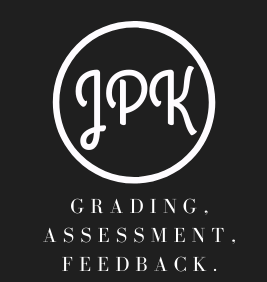
One of my 2023 goals is to blog on a regular basis, and so far this year, it’s been a major failure.
But I’m not ready to give up quite yet.
To make this goal more realistic for my current schedule and habits, I’ve decided on three action steps for future posts:
- they will be short,
- they will often be a continuation of a previous tweet (from my @joshkunnath Twitter account), and
- they may not be entirely polished.
So with no further ado, this is my first post in this new unambitious format.
Beginning Grading Conversations
Many schools, including mine, have regularly scheduled teacher collaboration time. While many teams already have full agendas for these meetings, including items such as planning curriculum, completing administrative tasks, and sharing best practices, one topic that is often omitted–intentionally or not–is grading.
But grading, of course, is an important teacher practice, and like other practices, teachers can improve this one with regular collaboration.
If nothing else, I encourage teachers to simply begin talking about grading. Because if you’re like many educators across the country, grading is a practice that is often kept private and even considered semi-sacred. But this mindset is exactly what has largely prevented the growth and improvement of teacher grading practices around the country for the last 100 years, while so many other practices have become more effective.
Short, regular grading conversations can increase the team’s comfort level with the topic and encourage teachers to open up about their own practices and the challenges they face. And with greater comfort, these short conversations can become longer, less arduous conversations. Further, discussion naturally promotes reflection, which is an essential step in professional growth.
So an easy way to start those discussions is by reserving a regular spot on the team meeting agenda for grading conversations–something like is shown below. And if grading isn’t a topic that your team has discussed in much depth, try starting with five minutes.

But most importantly, make it regular-whether it’s every week or every other week. By regularly devoting a small portion of your time to grading (likely less than 10%), you and your team are investing time into grading improvement.
Further, you and your team are developing a routine for talking, thinking, reflecting, and easing into any potential grading change. Then when you become more comfortable, you can consider gradually increasing the time or designating specific grading agenda items (e.g., retake policies or the percentage scale).
Grading Discussion Tips
To have a regular five-minute grading discussion, you and your team need some structure. Otherwise, the planned five minutes can easily turn into the entire meeting. Or perhaps even worse, the five minutes can quickly become contentious because of the strong emotions that sometimes accompany grading conversations.

So here are a few tips to maximize the effectiveness of this time:
- Determine a time limit, and stick to it. Whether it’s five minutes or more, designate a time keeper, and stop when the time is up.
- Choose a grading topic or prompt before the meeting. This can help to focus your conversations. See my Twitter posts for some ideas (@joshkunnath).
- Follow a discussion protocol. This will help your team to be focused and efficient with your time-something especially important with the often-divisive topic of grading.
Grading Discussion Protocol
A discussion protocol is another tool to help your team be focused and efficient with your limited time. While many exist, here’s a simple protocol that I suggest for grading discussions.

- Personal Thoughts (round robin; time: 20-30%). Each teacher in the team shares their thoughts on the topic without additional team comments or feedback. The purpose of this step is two fold: 1) to allow each group member to voice their own ideas without interruption from or influence of other members and 2) to enable the group to listen and understand the perspectives of each member. Optional extension: Have an open discussion immediately following the round robin share-out to dig deeper into the ideas that inevitably arise in the first step. This extension is time-permitting and shouldn’t be done at the expense of steps two and three of the protocol.
- Classroom and School-wide Implications (open forum, time: 40-50%). This is an opportunity for the team to brainstorm ways in which the grading topic does or can impact the classroom or school. Implications arise in both negative and positive forms, and discussion can range from short-term problems to long-term solutions. It’s important that discussion addresses implications within each teacher’s classroom, across the team’s classrooms, and across classrooms around the school (although this will likely require on-going discussion in future meetings).
- Action Steps (round robin, time: 20-30%). The protocol finishes with one or more action steps from each group member. Without action steps, grading discussions have minimal impact on students, so this last step is crucial for meaningful reform. Action steps might be similar or different for each team member, but it’s just as important to hear from each member at the end of the protocol as it is at the beginning.
Let me know what you think! Add a comment, @ me on Twitter @joshkunnath, or email me at joshkunnath@gmail.com.

This is extremely helpful.
LikeLike
I’m so glad to hear that, Theresa!
LikeLike